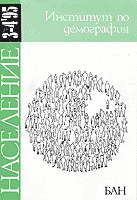Демографската ситуация в България
The Demographic Situation in Bulgaria
Author(s): Minko MinkovSubject(s): Social Sciences
Published by: Институт за изследване на населението и човека - Българска академия на науките
Summary/Abstract: This article is based on the report given by the author to the European Committee of population at the Council of Europe and published in French and English in 1994. In the beginning attention is paid to the actual population growth considered on the basis os the Population Censuses. It is for the first time that the data from the last Census of 1992 exhibit a depopulation of 0.78 percent annually. The second division of the article deals with the demographic transition in Bulgaria as determined by the natural increase of the population. The different stages are traced — from the positive growth (till 1924) to the approach of the zero growth of the population observed in the end of the 80s. Attention is paid also to the depopulation which starts here in the beginning of the 90s, when in the countries from Western Europe it is already overcome. In the third division attention is paid to marriages as the basis for family formation. Its stability is noticed of about 8-10% till the middle of the 80s, followed by a drastic decrease in the beginning of the 90s. Divorces in Bulgaria are still at a relatively low level which is typical for the countries from Eastern Europe. The fourth division is devoted to natality, by tracing the different stages in its development till World War II and after the war. Special attention is paid to the low level of natality in the beginning of the 90s, which was overpassed by the level of mortality and thus has contributed to the appearance of depopulation. More precise measures are also used, such as the total fertility rate and the net-reproduction rate, which also confirm the depopulation. The basic factors which determine natality are also considered. Mortality is considered in the fifth division, by consecutively researching its decrease to the middle of the 60s and its incrrease in order to reach one of the highest levels in Europe. The high level of infant mortality is also considered, along with the decrease to some extent of the average expectation of life for males, and the basic causes of mortality. The sixth division reports research on tendencies in internal and external migration. The inference is made that he decrease in internal migration is transformed into an increase in the external migration. The economic and social consequences for the state of the intensive emigration during the last few years are considered. The eighth division gives a discussion on the demographic structures by tracing the changes in the sex and age structure of the population. The transition from a progressive to a regressive type of age composition is researched, along with the decrease in the labour force and the increase in the demographic burden. In the end attention is paid (in the eighth division) on the population development policy.
Journal: Население
- Issue Year: 1995
- Issue No: 3+4
- Page Range: 7-38
- Page Count: 32
- Language: Bulgarian
- Content File-PDF

